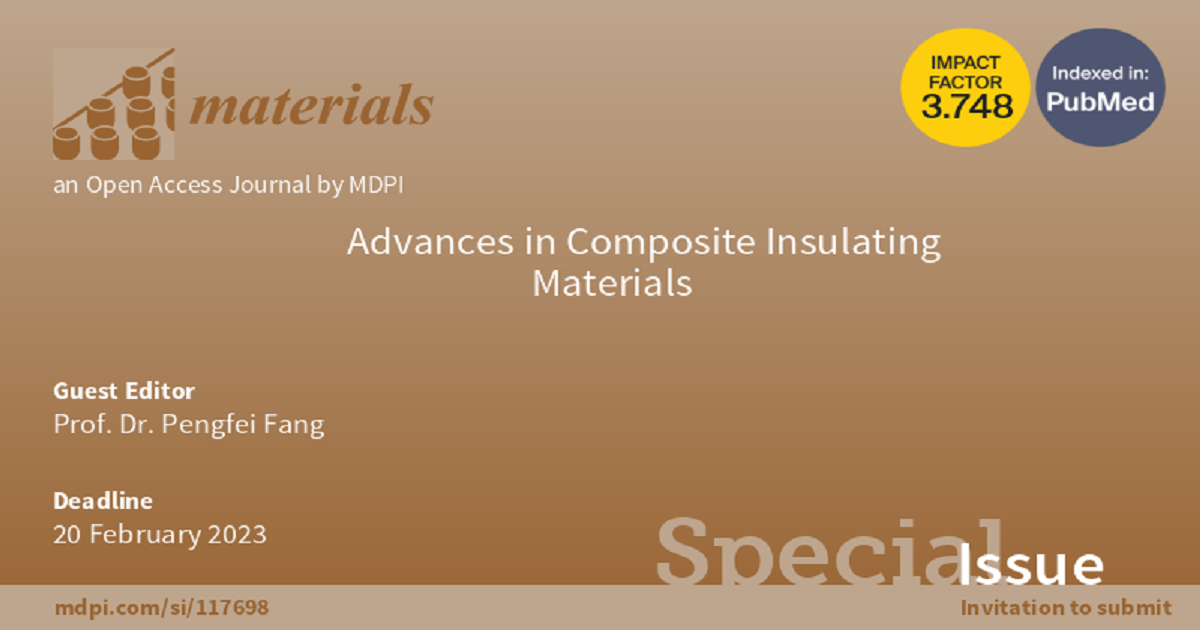Advances in Composite Insulating Materials
A special issue of Materials (ISSN 1996-1944). This special issue belongs to the section "Polymeric Materials".
Deadline for manuscript submissions: closed (20 August 2023) | Viewed by 5104

Special Issue Editor
Interests: nanomaterials; nanocomposites; composite insulator; piezocatalysis; photocatalysis; polymer composites
Special Issues, Collections and Topics in MDPI journals
Special Issue Information
Dear Colleagues,
In the past two decades, the field of composite insulating materials has significantly developed through many valuable discoveries and improvements. This includes the improvement of their electrical, thermal and mechanical properties, expanding their application and indicating the possibility of electrical equipments’ further advancement.
Various types of composite materials, comprising either microscaled or nanoscaled inorganic particles, have found extensive application in power and high-voltage engineering. In particular, micro- and nanotechnologies represent new approaches towards improved insulation systems that can operate at higher electrical stress and in more hostile environments. Along with material performance, basic research and development of “advanced” materials in the field of polymer base composites are also pursuing energy-efficient and low-cost manufacturing routes in order to transform these new material concepts into marketable products.
This Special Issue will offer an overview of the latest developments in the field of composite insulating materials. The articles presented in this Special Issue will cover various topics, including, but not limited to: high-temperature vulcanized silicone rubber (HTV), room-temperature vulcanized silicone rubber (RTV), epoxy composite insulating materials, polymer composite insulating coatings, fiber-reinforced insulating material, polyolefin composite insulating material, polymer nanocomposite insulating material and so on. Papers may also consider the design, characterization, properties and applications of advanced composite insulating materials.
Prof. Dr. Pengfei Fang
Guest Editor
Manuscript Submission Information
Manuscripts should be submitted online at www.mdpi.com by registering and logging in to this website. Once you are registered, click here to go to the submission form. Manuscripts can be submitted until the deadline. All submissions that pass pre-check are peer-reviewed. Accepted papers will be published continuously in the journal (as soon as accepted) and will be listed together on the special issue website. Research articles, review articles as well as short communications are invited. For planned papers, a title and short abstract (about 100 words) can be sent to the Editorial Office for announcement on this website.
Submitted manuscripts should not have been published previously, nor be under consideration for publication elsewhere (except conference proceedings papers). All manuscripts are thoroughly refereed through a single-blind peer-review process. A guide for authors and other relevant information for submission of manuscripts is available on the Instructions for Authors page. Materials is an international peer-reviewed open access semimonthly journal published by MDPI.
Please visit the Instructions for Authors page before submitting a manuscript. The Article Processing Charge (APC) for publication in this open access journal is 2600 CHF (Swiss Francs). Submitted papers should be well formatted and use good English. Authors may use MDPI's English editing service prior to publication or during author revisions.
Keywords
- high temperature vulcanized silicone rubber (HTV)
- room temperature vulcanized silicone rubber (RTV)
- epoxy composite insulating materials
- polymer composite insulating coatings
- fiber-reinforced insulating material
- polyolefin composite insulating material
- polymer nanocomposite insulating material






